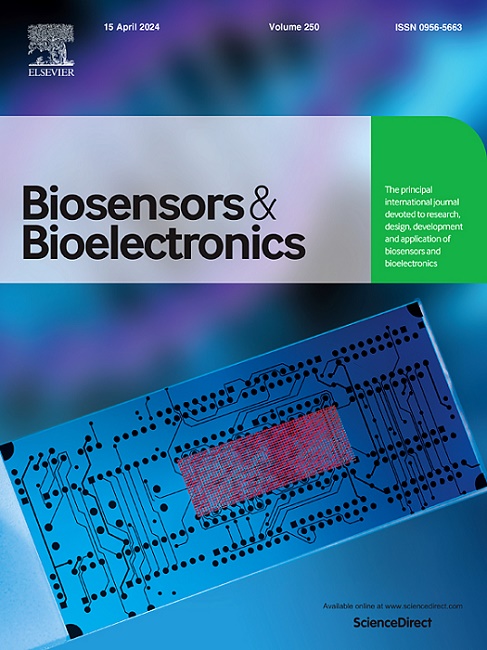A novel GLUT-4 electrochemical immunosensor based on a poly(thionine)-gold nanoparticle nanocomposite: Combining complex capacitance and dissolved oxygen to obtain an analytical signal
IF 10.7
1区 生物学
Q1 BIOPHYSICS
引用次数: 0
Abstract
Detection of glucose transporter 4 (GLUT4) is essential for understanding various physiological and pathological processes. This work reports the development of a novel electrochemical immunosensor for the direct detection of GLUT4, employing dissolved oxygen as a redox probe. This molecular oxygen-sensitive response is mediated by a redox-conductive polymer based on thionine. The sensor platform was fabricated via a one-step electropolymerization of thionine and gold nanoparticles (AuNPs) onto a platinum screen-printed electrode (Olean-Oliveira et al., 2022a). The immunosensor was then constructed by physical adsorption of a GLUT4 antibody onto the poly(thionine)-AuNP composite surface. This label-free approach eliminates the need for secondary antibodies or enzymes. The immunosensor performance was evaluated using electrochemical impedance spectroscopy (EIS). The sensing mechanism relies on impedance changes; increasing GLUT4 concentrations lead to increased impedance due to enhanced surface blocking upon GLUT4-antibody binding. This interaction impedes oxygen diffusion to the polymer redox sites, resulting in increased electrical resistance. Analysis of the redox capacitance as a function of frequency demonstrates a decrease in the capacitive arc with increasing GLUT4 concentration.
求助全文
约1分钟内获得全文
求助全文
来源期刊

Biosensors and Bioelectronics
工程技术-电化学
CiteScore
20.80
自引率
7.10%
发文量
1006
审稿时长
29 days
期刊介绍:
Biosensors & Bioelectronics, along with its open access companion journal Biosensors & Bioelectronics: X, is the leading international publication in the field of biosensors and bioelectronics. It covers research, design, development, and application of biosensors, which are analytical devices incorporating biological materials with physicochemical transducers. These devices, including sensors, DNA chips, electronic noses, and lab-on-a-chip, produce digital signals proportional to specific analytes. Examples include immunosensors and enzyme-based biosensors, applied in various fields such as medicine, environmental monitoring, and food industry. The journal also focuses on molecular and supramolecular structures for enhancing device performance.
 求助内容:
求助内容: 应助结果提醒方式:
应助结果提醒方式:


